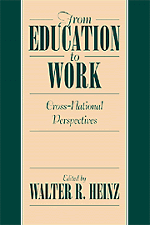Book contents
- Frontmatter
- Contents
- Contributing Authors
- Preface
- Introduction: Transitions to Employment in a Cross-National Perspective
- Part I Social Origin, Gender, and Transition Patterns
- Part II Education and Labour Markets: Work Experiences, Skills, and Credentials
- Part III Changes in the Social Context of Transitions
- 10 Institutional Networks and Informal Strategies for Improving Work Entry for Youths
- 11 School-to-Work Transitions and Postmodern Values: What's Changing in Canada?
- 12 Education and Employment in Great Britain: The Polarizing Impact of the Market
- 13 From Systems to Networks: The Reconstruction of Youth Transitions in Europe
- References
- Index
10 - Institutional Networks and Informal Strategies for Improving Work Entry for Youths
Published online by Cambridge University Press: 30 September 2009
- Frontmatter
- Contents
- Contributing Authors
- Preface
- Introduction: Transitions to Employment in a Cross-National Perspective
- Part I Social Origin, Gender, and Transition Patterns
- Part II Education and Labour Markets: Work Experiences, Skills, and Credentials
- Part III Changes in the Social Context of Transitions
- 10 Institutional Networks and Informal Strategies for Improving Work Entry for Youths
- 11 School-to-Work Transitions and Postmodern Values: What's Changing in Canada?
- 12 Education and Employment in Great Britain: The Polarizing Impact of the Market
- 13 From Systems to Networks: The Reconstruction of Youth Transitions in Europe
- References
- Index
Summary
The school-to-work transition in the United States is not working. The “forgotten half,” students who do not complete a college degree, have trouble getting good jobs, getting any jobs, or keeping jobs, and employers complain that they cannot get workers with good academic skills and work habits (William T. Grant Foundation, 1988a, 1998b). The problems are especially great for disadvantaged youths. Most analyses have traced problems in the school-to-work transition to deficiencies in students or in schools, so reforms have tried to “repair” youths or schools, yet few studies have looked at the transition itself. If society is to increase the employment rate of the “forgotten half,” more attention must be given to the transition process, which our studies suggest can be improved by school-to-work networks and trusted signals of youths' value.
Networks for Low-Income Youths
We know how some youths get jobs – they use contacts. Family, friends, and neighbors tell youths about jobs and put in a good word. Family networks help many youths get jobs. This explains part of the difficulty for low-income youths – their family and friends lack job contacts. This points to a direction for policy to help low-income youths get jobs: give them contacts.
- Type
- Chapter
- Information
- From Education to WorkCross National Perspectives, pp. 235 - 259Publisher: Cambridge University PressPrint publication year: 1999
- 4
- Cited by



